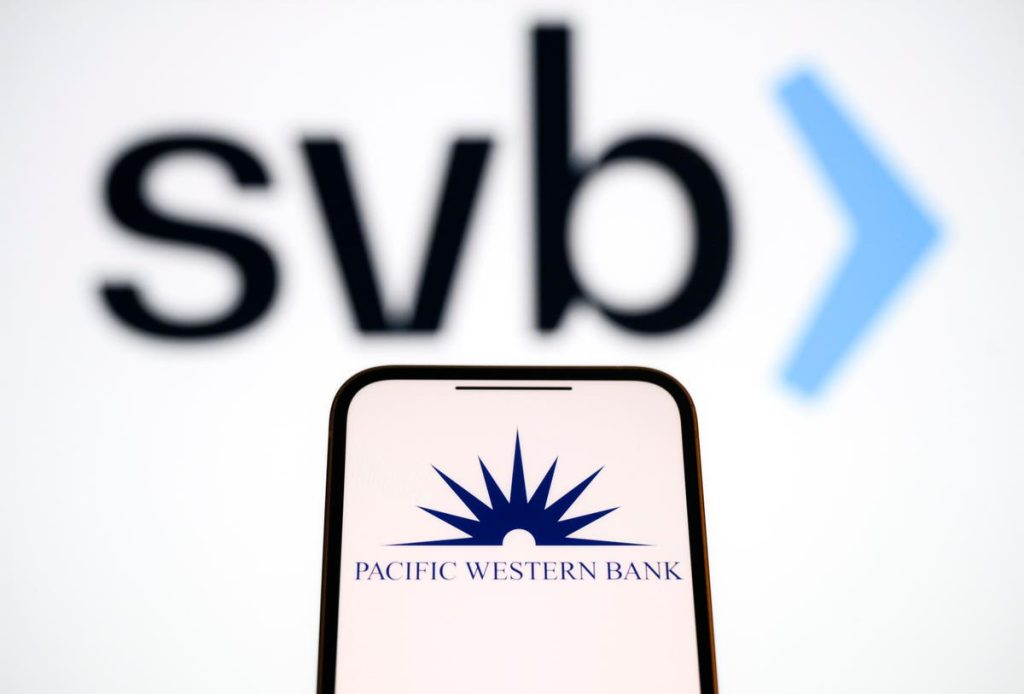“Confidence in a financial institution is built over decades and destroyed in days. As each domino falls, the next weakest bank begins to wobble,” said Bill Ackman this afternoon.
Well, PacWest is the next domino. Today its stock plummeted over 50% – down almost 90% year-to-date. The latest casualty from the loss in investor confidence in the regional banking system following the collapse of Silicon Valley Bank, alongside Signature Bank and First Republic Bank.
Some argue that PacWest is even less deserving of investors and depositors jumping ship than its failed peers. Since March, PacWest’s core deposits have actually increased to $28 billion. And while SVB ranked dead last in uninsured deposits, with over 93% of customer deposits uninsured, PacWest was in 3x better shape with under 30% deposits uninsured in Q1. Nevertheless, when the bank mentioned it was exploring “a potential sale,” investor sentiment instantly evaporated.
Perhaps, the Fed is to blame. After all, Jerome Powell hiked rates yesterday for the 10th time in just over a year, the fastest pace in decades, knowing the impact it might have on a small banks’ balance sheet. What about the bank executives who decided to take duration risk in a rising rate environment? Or perhaps it’s the Twitter influencers stirring the pot? Personally, I think there’s plenty of finger pointing to go around. But that’s not productive…
One thing is for certain, with an implicit government guarantee, the Too Big To Fail banks are the real winners today. Meanwhile the startups and small businesses – those who value white glove service and customized financial products – are the losers. Founders and operators are at the mercy of fickle investors, antiquated big banks and unresponsive regulators. Especially J.P. Morgan Chase, who managed to back regulators into a corner, allowing Jamie Dimon to gobble up First Republic in a single bite.
The $92 billion in deposits that JPM assumed from its First Republic purchase is a mere rounding error compared to the $2.4 trillion that they have under management. Yet, the deposits are a stark reminder that antitrust oversight is no match for a banking crisis.
Given the continued fear in the regional banking system, and the domino effect that is currently underway, one might wonder if J.P. Morgan Chase will continue devouring deposits of smaller peers as they fail.
Thankfully for depositors, Chase isn’t only name in town anymore. Fintechs now also have a seat at the table. By some measures, BAM Fintechs (Brex, Arc and Mercury), took in nearly 30% of the outgoing deposits in the aftermath of the SVB collapse.
Some people believe that scale is all that matters in tech banking these days. And at first, that seemed true. But there’s a reason why J.P. Morgan Chase and Wells Fargo didn’t win 100% of deposits outright: Too Big To Fail banks are structurally unfit to serve the hypergrowth tech companies that SVB spent decades winning over.
Venture backed startups require more than just a strong brand name, big balance sheet, and FDIC coverage. They need access to capital products that are tailored to explosive growth software companies that burn more cash than they make—lines of credit, ARR financing, and venture debt made available long before they are cash flow positive. They need access to institutional-grade treasury solutions that allow founders and CFOs to optimize between liquidity and yield preferences. Most importantly, they deserve dedicated white glove support from Relationship Managers who understand their business coupled with an intuitive User Interface that empowers users to never speak to a banker if they so choose.
That’s where the BAM (Brex, Arc, Mercury) Fintechs come in. Unlike regional banks that hold uninsured deposits on their balance sheets, Arc partners with the largest financial institutions in the world to provide a brand-name banking experience with over 20x the standard level of FDIC coverage. At the same time, like the regional banks, Arc provides access to capital, treasury management and dedicated support that is purpose built for the unique community it serves.
While I’m not sure if more dominoes will fall in the regional banking system this year, one thing is clear to me — the future of banking for Silicon Valley will not be a bank at all.
Read the full article here



